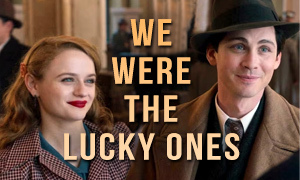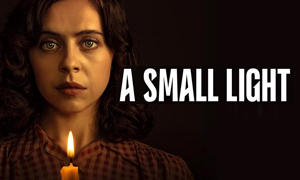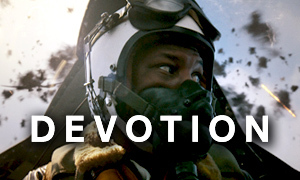Lone Survivor: History vs. Hollywood
based on the book 'Lone Survivor' by Marcus Luttrell and Patrick Robinson
| REEL FACE: | REAL FACE: |
Mark Wahlberg
Born: June 5, 1971 Birthplace: Dorchester, Boston, Massachusetts, USA | Marcus Luttrell
Born: November 7, 1975 Birthplace: Houston, TX, USA Rank: Hospital Corpsman First Class |
Taylor Kitsch
Born: April 8, 1981 Birthplace: Kelowna, British Columbia, Canada | Michael Patrick Murphy
Born: May 7, 1976 Birthplace: Smithtown, New York, USA Death: June 28, 2005, Kunar Province, Afghanistan (killed in action) Rank: Lieutenant, Team Commander |
Ben Foster
Born: October 29, 1980 Birthplace: Boston, Massachusetts, USA | Matthew 'Axe' Axelson
Born: June 25, 1976 Birthplace: Cupertino, California, USA Death: June 28, 2005, Kunar Province, Afghanistan (killed in action) Rank: Sonar Technician 2nd Class |
Emile Hirsch
Born: March 13, 1985 Birthplace: Palms, California, USA | Danny Dietz
Born: January 26, 1980 Birthplace: Aurora, Colorado, USA Death: June 28, 2005, Kunar Province, Afghanistan (killed in action) Rank: Gunner's Mate 2nd Class |
Eric Bana
Born: August 9, 1968 Birthplace: Melbourne, Victoria, Australia | Erik S. Kristensen
Born: March 15, 1972 Birthplace: Portsmouth, Virginia, USA Death: June 28, 2005, Afghanistan (helicopter shot down) Rank: Lieutenant Commander |
Alexander Ludwig
Born: May 7, 1992 Birthplace: Vancouver, British Columbia, Canada | Shane Eric Patton
Born: November 15, 1982 Birthplace: Boulder City, Nevada, USA Death: June 28, 2005, Afghanistan (helicopter shot down) Rank: Petty Officer Second Class |
Ali Suliman
Born: 1977 Birthplace: Nazareth, Israel | Mohammad Gulab
|
Yousuf Azami
| Ahmad Shah
Born: ca. 1970 Death: April 2008, Khyber Pakhtunkhwa, Pakistan (shootout with Pakistani police) |
Did Marcus Luttrell's heart really stop after he was rescued?
No. The Lone Survivor movie begins with Marcus Luttrell (Mark Wahlberg) flatlining after being rescued. We then flash back three days to just prior to the start of the ill-fated mission. However, this part of the true story is significantly less dramatic. Luttrell was not near death when he was rescued and his heart never stopped beating. In reality, he and the Army Rangers took time to have a lengthy debriefing over tea, during which some of the villagers were present as well, including Gulab. Eventually, they bid the villagers farewell and boarded the rescue chopper. -Lone Survivor Book
What was the purpose of Operation Red Wings?
The purpose of Operation Red Wings, which began on June 28, 2005, was first to identify Ahmad Shah, a key Taliban loyalist and leader believed to be hiding on the slopes of a mountain named Sawtalo Sar, located in the Pech District of Afghanistan's Kunar Province. After Marcus Luttrell and his three fellow SEALs carried out their reconnaissance and surveillance to indentify Shah and his men, the military could then engage the Taliban loyalists and disrupt the Anti-Coalition Militia (ACM) activity in the region. Shah, who was not part of the Taliban but sought allegiance with them, rose to power in the region after the forced surrender of an ACM leader named Najmudeen in 2005.
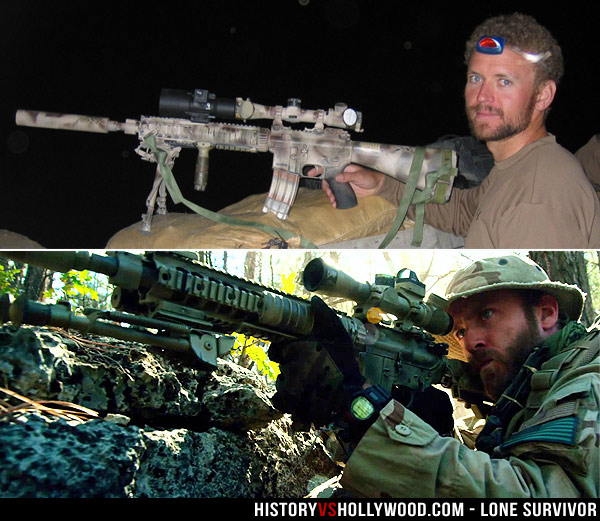
For Matthew 'Axe' Axelson (top) and the rest of his team, the surveillance and reconnaissance mission quickly turned into a harrowing battle, similar to what Axe (Ben Foster, bottom) and his teammates endure in the Lone Survivor movie.
Why was the military operation named Operation Red Wings?
As we began our research into the Lone Survivor true story, it quickly became apparent that the name was often mis-stated as "Operation Redwing" and sometimes "Operation Red Wing." The origin of the name being misspelled and mispronounced began with the publication of Marcus Luttrell's book, Lone Survivor: The Eyewitness Account of Operation Redwing and the Lost Heroes of SEAL Team 10, which was ghostwritten by Patrick Robinson based on interviews he conducted with Luttrell.
The name Operation Red Wings originated from a naming convention used by the previous battalion, the 3rd Battalion of the 3rd Marines (3/3), whose commander, Lieutenant Colonel Norman Cooling, named his operations after Texas sports teams. When the 2nd Battalion of the 3rd Regiment (2/3) arrived, they further developed one of the previous battalion's operations, tentatively titled Operation Stars (named after the Dallas Stars hockey team). In keeping with the tradition of using a hockey team name, the 2/3 chose Operation Red Wings, named after the Detroit Red Wings hockey team.
Is the training footage at the beginning of the movie real Navy SEAL footage?
Yes. The training footage at the beginning of the movie is archive footage that was commissioned by the Navy. Director Peter Berg needed a way to sum up the training and selection process chronicled in Luttrell's book, which spans approximately 80 pages. -Thompson on Hollywood
Were they really spotted by three Afghan goatherds?
Yes, but unlike the movie, only one of them was a boy, not two. In comparing the Lone Survivor true story vs. the movie, we learned that the four members of SEAL Team 10, including Lt. Mike Murphy (portrayed by Taylor Kitsch), Hospital Corpsman 2nd Class Marcus Luttrell (played by Mark Wahlberg), Gunner's Mate 2nd Class Danny Dietz (portrayed by Emile Hirsch), and Sonar Technician 2nd Class Matt Axelson (played by Ben Foster), were discovered high in the mountains by three local goatherds, one of whom was a boy around the age of fourteen. -Lone Survivor Book
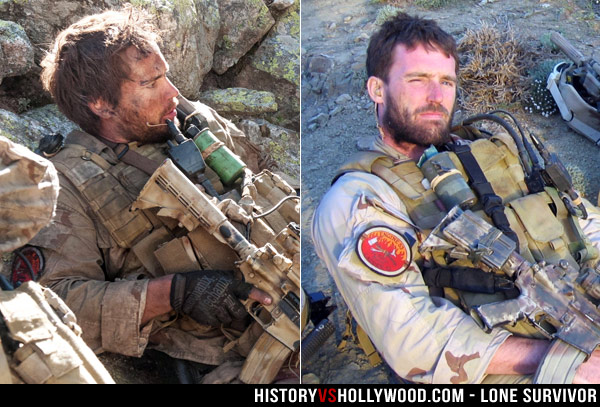
Like in the movie, the real Lt. Mike Murphy (right) sacrificed himself to make a call for help. He was awarded the Medal of Honor for his selfless action. Actor Taylor Kitsch (left) can be seen wearing Murphy's recognizable Engine 53 patch in the movie, a tribute to the fallen rescue workers at Ground Zero on 9/11.
Did they take a vote on whether or not to kill the three goatherds (as depicted in Luttrell's book)?
"This is not a vote," Lt. Mike Murphy (Taylor Kitsch) says in the film, contradicting Marcus Luttrell's book, in which the four SEALs are depicted taking a vote on whether to kill the three goatherds or let them go. The "vote" in the book has sparked a significant amount of controversy and debate, prompting readers to take to online blogs and forums to argue the Rules of Engagement (ROE) and morality in combat. Some expressed outrage that the fate of three civilian's lives would come down to a vote, while others saw their deaths necessary for the mission and the team's survival. "[Killing civilians] was the total antithesis of every bone in his body," Lt. Murphy's father, Dan, told the Daily News in 2007. In Luttrell's book, Murphy's main argument for letting them go was to prevent the U.S. liberal media from attacking them and seeing that they were charged with murder.
"Mike Murphy made that decision. It wasn't a vote," says director Peter Berg, who spent a great deal of time with Marcus Luttrell, both on the set and prior to filming (Jeff Goldsmith Q&A Podcast). However, it should be noted that in making the movie, Berg had promised the families of the fallen, including the Murphys, that he would pay the utmost respect and do nothing to dishonor the memory of their loved ones.
The book also implies that the deciding vote was Luttrell's, ultimately leaving the decision up to him, something that has also been contested. What is certain is that there was a discussion during which each SEAL gave his two cents. The mission's commander, Lt. Mike Murphy, then made the final decision to let the three goatherds go, obeying the military's ROE (Rules of Engagement). It is certainly possible that the book's ghostwriter, British author Patrick Robinson, who had made a name for himself in part by writing Navy SEAL fiction, could have interpreted the input of each SEAL as a "vote" instead of a discussion. It is also likely that Lt. Murphy would put a lot of value on Luttrell's opinion, given that Luttrell had more combat experience, but in the end, as the mission's commander, the decision was ultimately Murphy's and this is in line with what the movie depicts. Watch Luttrell stand up to an interviewer who believes there was only one right decision.
Did the three goatherds alert the Taliban fighters?
Given that the Taliban fighters had set up their ambush just over an hour and a half after the goatherds were let go, there is little doubt that the goatherds informed the Taliban of the position of the four Navy SEALs. It is also possible that the Taliban militants had been aware that the SEALs were in the area almost immediately after the SEALs hit the ground. This would help to explain the quickness with which the Taliban fighters set up the ambush. It is not uncommon for the Taliban to send old men and children (the goatherds) into an area to pinpoint the location of U.S. soldiers, especially when they know the U.S. Rules of Engagement forbid the killing of civilians, therefore guaranteeing that the civilians will be able to return with the location of the U.S. soldiers. -Jeff Goldsmith Q&A Podcast
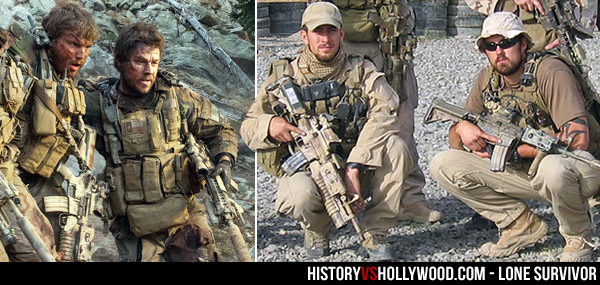
A wounded Danny Dietz (Emile Hirsch) is helped by Marcus Luttrell (Mark Wahlberg) in the movie (left). Right: The real Danny Dietz and Marcus Luttrell in Afghanistan in 2005.
Were they really ambushed by up to 200 Taliban fighters?
The number of enemy fighters that ambushed the four SEALs (Lt. Mike Murphy, Hospital Corpsman 2nd Class Marcus Luttrell, Gunner's Mate 2nd Class Danny Dietz, and Sonar Technician 2nd Class Matt Axelson) is the most frequently contended aspect of the book. In the Lone Survivor movie, the SEALs are ambushed by approximately 50 Taliban fighters. However, the book asserts that the Taliban fighters consisted of between "80 and 200 armed men." Dozens of articles on the internet say that in his own After Action Report (AAR), Marcus Luttrell estimated that the team was attacked by 20 to 35 enemy fighters (Anti-Coalition Militia). The issue here is that none of the writers of these articles have actually seen the AAR report, which doesn't seem to exist online. Most refer back to the articles of journalist and author Ed Darack, who released a competing book titled Victory Point.
However, Lieutenant Michael Murphy's official Medal of Honor citation states that "between 30 and 40 enemy fighters besieged his four-member team," which is significantly lower than the Lone Survivor book. Murphy's Summary of Action report posted on the Navy's website lists a slightly higher number but still in the same range, referring to an "enemy force of more than 50 anti-coalition militia." This more closely corroborates the movie, in addition to the claims made about Luttrell's After Action Report. It stands as evidence that the number of enemy combatants was likely exaggerated for the book.
How long did the battle last in real life?
Following the ambush, the battle that ensued between the four Navy SEALs and the Taliban loyalists lasted over three hours. For the film, director Peter Berg condensed the fight into 30 sequences or segments, treating each one as a "mini film experience." -Thompson on Hollywood
Did the soldiers really jump off the cliffs?
Yes. According to the Lone Survivor true story, Marcus Luttrell and his three fellow comrades of SEAL Team 10 were left with no choice but to jump off the cliffs, making leaps of 20 to 30 feet in order to evade the pursuing Taliban fighters, as shown in the movie. -Navy.mil
Are the injuries sustained by the SEALs in the movie accurate?
Yes. Director Peter Berg was given access to autopsy reports and used them to recreate the injuries sustained by the four Navy SEALs in the film. Berg also worked with the costume department to make sure that the clothing replicated the men's injuries as accurately as possible. -Production Notes
What were the extent of Marcus Luttrell's injuries?
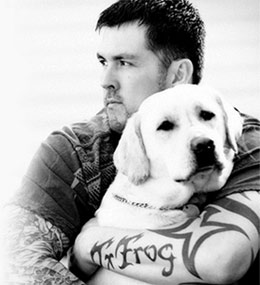
To help with his emotional scars from Operation Red Wings, Marcus Luttrell enlisted the help of a service dog named Mr. Rigby.
Luttrell also suffered a torn shoulder, a broken nose, and is still dealing with the effects of the bacteria that was in the water that he ingested as he tried to quench his severe thirst while struggling to survive (Ed Young Interview). He was also shot in the back the following day, which is not shown in the movie (The Daily Beast).
After he was rescued, his physical wounds from Operation Red Wings slowly began to heal, but his emotional wounds ran much deeper. He did return to duty, serving in Ramadi, Iraq in 2006, only to be forced to retire after getting his knees blown out and his spine fractured again during a raid (The Daily Beast). He had also still been plagued by his previous injuries, which he had not given enough time to heal. To help with his emotional and psychological wounds, he has since enlisted the help of a service dog that he calls Mr. Rigby (pictured).
How many soldiers died during Operation Red Wings?
19 soldiers were killed during Operation Red Wings and one was wounded (Marcus Luttrell). The casualties included the three Navy SEALs caught in the ambush with Marcus Luttrell and 16 other U.S. soldiers (8 Navy SEALs and 8 U.S. Army Special Operations aviators) who lost their lives when their MH-47 Chinook helicopter was shot down on its way to rescue the ambushed soldiers.
Did the real Marcus Luttrell actually see his three SEAL teammates die?
Yes. According to Luttrell, the deaths of Murphy, Dietz and Axe happened much like they do in the movie. In real life, Danny Dietz died in Luttrell's arms after suffering multiple bullet wounds, with the shot that killed him striking him in the face as Luttrell was dragging him along. This differs somewhat from the movie, which depicts Danny Dietz (Emile Hirsch) as still being alive when the Taliban come upon him. The shot that kills him in the film comes around the same time that Murphy (Taylor Kitsch) is dying on top of the rock.
In the book, just after Lieutenant Mike Murphy was shot through his chest, he walked out into the open ground, away from the cliff walls (which would interfere with reception), sat on a small rock and called HQ. While on the phone he was shot in the back, with the bullet exiting his chest. However, unlike the movie, he rose to his feet and staggered into a "firestorm." As he shot back, he climbed into a "rock strata" about thirty yards up the mountain where he made his final stand. It was from there that he screamed out to Luttrell for help, but Luttrell was pinned down and badly injured. Eventually, the screaming stopped.
Marcus Luttrell then reached Axe, who was sitting in a hollow and slowly dying from a massive wound to his head, among other injuries. He told Luttrell to tell his wife Cindy that he loved her and as Marcus watched him slip away, a Russian grenade landed close to them and blew Marcus out of the hollow and over the edge of a ravine. In the book, Marcus states that Axe "could not possibly have lived through the blast." This contradicts the movie, which shows Axe being shot in the head as he's slumped against a tree. -Lone Survivor Book
Did the real Marcus Luttrell see the helicopter go down?
No. "In real life I was unaware of that," says Luttrell. "I didn't know that had happened. It was well towards the end of the gunfight and I had already crawled into a crevice and buried myself." -The Daily Beast
Was Marcus Luttrell really able to still walk after the battle?
No. In the movie we see a severely wounded Marcus Luttrell (Mark Wahlberg) walking around following the battle. "I was paralyzed from the waist down," says the real Luttrell. "In the movie they had me walking around. I didn't walk. I crawled for over seven miles that first night and was shot again." -The Daily Beast
Was Marcus Luttrell really saved by a man who hid him in his Afghan village?
Yes. The Lone Survivor movie character Gulab (Ali Suliman) is based on a real person who was a member of a Pashtun village. In assisting Luttrell, Gulab was obeying a Pashtun code of honor called Pashtunwali. "Pashtunwali is a respect," the real Mohammad Gulab told 60 Minutes, "a respect for a guest who comes knocking at your door, and even if he is in need or he is in imminent danger, we must protect him. I knew I had to help him, to do the right thing, because he was in a lot of danger." Watch the 60 Minutes interview.
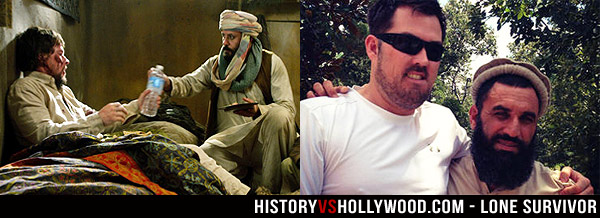
Left: Mark Wahlberg's character is helped by Gulab (Ali Suliman) in the movie. Right: Luttrell with the real Mohammad Gulab (right), who has visited him in the U.S. on several occasions. Luttrell wants Gulab to seek asylum for himself and his family.
In real life, Mohammad Gulab (pictured with Luttrell) has since moved out of the village because he and his family had become top Taliban targets. "They have a bounty on his head," Luttrell says. "He's been shot, his car's been blown up, and his house has been burned down." In addition, his cousin has been killed (60 Minutes). He has gone into hiding with his wife and ten children, but Marcus Luttrell and director Peter Berg fear that the film will bring renewed attention upon Gulab from the Taliban. They are currently working on obtaining asylum in the U.S. for Gulab and his family. In the years since Luttrell's rescue, Gulab has made several trips to the U.S. to spend time with his friend, whose life he saved. -MensJournal.com
For how long did Gulab hide the real Marcus Luttrell?
Though the time elapsed seems rather brief in the movie, the Lone Survivor true story reveals that the real Gulab hid Marcus Luttrell for four days, moving him from house to house in his Pashtun village and even into a cave to avoid the pursuing Taliban. "The Taliban came and sat down with me," says the real Mohammad Gulab. "I said, 'No, I will not hand him over to you.' ... They told me, 'You will die. Your brother will die. Your cousins will die. Your whole family will die. It's not worth it. Give us the American,' and I said 'No, I will protect him 'til the end.'" Like in the movie, Luttrell was eventually rescued by U.S. forces who had been scouring the mountains for as long as he had been in hiding. -60 Minutes
Was Marcus Luttrell almost beheaded by Ahmad Shah's fighters?
No. In the movie, we see Luttrell (Mark Wahlberg) being dragged to a log where Shah's soldiers intend to behead him. However, just as they raise their machete over Luttrell, the villagers arrive with guns and save him. In real life, this suspenseful scene never happened. In the book, eight Taliban fighters barged into the room and beat Luttrell, breaking the bones in his wrist. They interrogated him for six hours, but they only threatened to behead him by telling him that they took the heads of his teammates and he was next. A village elder eventually came in and forbid the Taliban from taking Luttrell away.
Did a child really help save Luttrell by giving him a knife?
No. In the movie, an injured Luttrell (Mark Wahlberg) is being strangled by a Taliban soldier but is saved when Gulab's son, a young boy, gives him a knife. He then stabs his attacker repeatedly in order to subdue him and survive. In real life, this scene never happened. In fact, the whole attack on the village at the end is Hollywood fiction. -Lone Survivor Book
Did U.S. forces really have to stop the Taliban from attacking the village like at the end of the movie?
No. In the film, U.S. helicopters and planes engage the Taliban, who are attacking the Pashtun village in search of Luttrell (Mark Wahlberg). After Gulab's house is blown apart, Gulab is shot in the back during the fight. U.S. soldiers eventually come to the rescue, storming through the village to locate Luttrell and get him to safety. This entire fight never happened. In real life, Mohammad Gulab was not shot in the back, nor was his house blown apart by an RPG when he and Luttrell were inside. The true story teaches us that Army Rangers and Afghan special forces actually rescued Luttrell in the woods when Gulab and several villagers were trying to get Luttrell to a safe location. -Lone Survivor Book
What happened to Ahmad Shah, the enemy leader the SEALs were looking for?
In April 2008, Ahmad Shah (also known as Commander Ismail) was killed during a shootout with Pakistani police in Khyber Pakhtunkhwa, Pakistan after failing to stop at a checkpoint near the Afghan border. Shah was attempting to smuggle a kidnapped Afghan day laborer to the Afghan side of the border, where he would then be taken to an insurgent hideout. -The Long War Journal
Did Marcus Luttrell retire from the military after Operation Red Wings?
No. After working with ghostwriter Patrick Robinson on the Lone Survivor book, and at the same time partaking in physical therapy for injuries he sustained during Operation Red Wings, Marcus Luttrell returned to Iraq, engaging in high-intensity urban fighting in the hostile city of Ramadi, the capital of the war-torn Anbar Province (Service: A Navy SEAL at War). While back in Iraq, Luttrell got injured again, blowing out his knees and fracturing his spine during a raid (The Daily Beast). In addition, his injuries from Operation Red Wings had not been given enough time to heal. As a result, he left the Navy in 2007 and was officially medically retired from duty in 2009. -Military.com
What has Marcus Luttrell done since his retirement from the military?
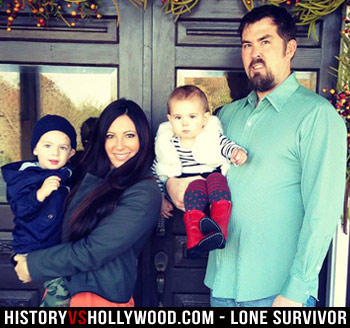
Marcus Luttrell with wife Melanie and children Axe and Addie in 2013.
Luttrell co-authored a second book, Service: A Navy SEAL at War, released in May of 2012, in which Luttrell shares some of his own combat stories, in addition to the stories of other SEALs. In 2010, he started the Lone Survivor Foundation to "restore, empower, and renew hope for our wounded service members and their families through health, wellness, and therapeutic support." In 2013, he founded the Patriot Tour with several other veterans and speakers. During the tour Marcus shares stories from his life as a SEAL, including Operation Red Wings and his journey since, like having to stomach being told that he was medically unfit to continue serving as a Navy SEAL.
Where was Lone Survivor filmed?
To replicate the rugged Hindu Kush mountain range of Afghanistan's Kunar Province, the filmmakers headed to New Mexico, filming on location in the Sangre de Cristo Mountains of the Santa Fe National Forest. Portions of the battle and the sets for the Shah village and the Pashtun village were recreated on the less treacherous terrain of Chilili, New Mexico. Additional filming took place on Kirtland Air Force Base in Albuquerque, as well as on soundstages at Albuquerque's I-25 Studios. -Production Notes
Did the filmmakers have the support of the military and the families of the fallen soldiers?
Yes. "My research started with meeting the families of the SEALs who were killed," says director Peter Berg. "I went to New York and met the Murphys. I went to Colorado and met the Dietzes, and I went to Northern California and met the Axelsons. After spending time with them, you realize that these kids were the best and the brightest; they were the stars of the families. The grief and the wounds are still very raw. You would have to be inhuman to not feel the responsibility when that kind of grief gets shared with you. ... I visited the Dietz home and Mr. Dietz took me to Danny's bedroom, which he's kept. It was the room of a teenage boy, but he had built this glass case and inside was Danny's uniform with the bullet holes in it and blood on it, as well as his gun, helmet and boots." Watch the families share their thoughts on the film.
Prior to filming, director Berg, who had previously worked with the Navy on his 2012 film Battleship, traveled to the Middle East and was embedded with a SEAL platoon in Iraq near the Syrian border. He spent a month with a team of 15, accompanying the soldiers on night patrols and observing how they operated. Survivor Marcus Luttrell also insisted on moving into Peter Berg's home for one month to ensure that the director knew exactly what unfolded on the mountain. -Production Notes
During the filming, Navy SEALs were on set at all times and acted as consultants on the 43-day shoot. Marcus Luttrell was present for much of the filming. -Thompson on Hollywood
Does the real Marcus Luttrell have a cameo in the movie?
Yes. The real Marcus Luttrell makes a significant appearance in at least two scenes in the movie, though he is present in others too. He first appears as one of the soldiers at the table who is lightheartedly hazing rookie SEAL Shane Patton (Alexander Ludwig) before the mission (Luttrell is the one who knocks over the drink and jokingly tells Ludwig's character that his new mission or 'op' is to clean up the mess).
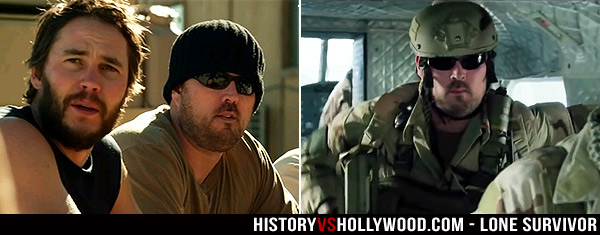
The real Luttrell has two significant cameos (among a few others). He can be seen early in the movie sitting at a picnic table with Taylor Kitsch (left). He can also be seen in the Chinook helicopter just before it is shot down (right).
Luttrell appears later as one of the 16 soldiers aboard the doomed Chinook helicopter that was sent to rescue him (pictured, right). The camera stops on him and several real-life SEALs just before the Taliban's rocket-propelled grenade enters the helicopter through an open bay door. "I was on the other side of the mountain when those guys came to help me," Luttrell says of his real-life experience, "so getting to die on the helicopter in the movie was a very powerful moment for me." -MensJournal.com
Lone Survivor Interviews, Movie Trailer and Related Video
Watch Marcus Luttrell interviews that provide more insight into the Lone Survivor true story vs. the movie. Listen to Luttrell share his thoughts on the decision to release the goatherds, his rescuer Mohammad Gulab and what it's like to have the story turned into a movie.
WATCH Marcus Luttrell Responds to Controversy Over Freeing the GoatherdsDuring this post-screening conversation
with director Peter Berg, retired Navy
SEAL Marcus Luttrell, and actor Taylor
Kitsch, Luttrell interjects to address the
moderator, who naively assumes that the
only "right thing" to do was to let the
goatherds go. Luttrell uninhibitedly
reminds her that moral and strategical
arguments could be made for either
decision. Luttrell's comments regarding
the controversy begin around the 13:32
mark, but the whole interview is worth a
look. |
WATCH Marcus Luttrell Interview Part 1 - 60 MinutesDuring this 60 Minutes interview,
former Navy SEAL Marcus Luttrell discusses
the 2005 battle in Afghanistan that
resulted in the largest loss of life for
Naval Special Warfare since WWII. Luttrell
describes the events in detail and opens
up about reaching his breaking point. |
WATCH Marcus Luttrell 60 Minutes Interview Part 2During another part of the Marcus Luttrell
60 Minutes interview, the Navy
SEAL recalls the 2005 battle in
Afghanistan and talks about the real
Mohammad Gulab, the Afghan man who rescued
him and hid him for four days, despite
demands by the Taliban that he give up
Luttrell. The real Gulab is also
interviewed. |
WATCH Lone Survivor - Family Members of the Fallen React to the MovieThe parents of the fallen heroes,
including Daniel and Maureen Murphy, Corky
and Donna Axelson, and Dan and Cindy
Dietz, react to the Lone Survivor
movie. Marcus Luttrell also speaks about
his reluctance to allow his true story to
become a film. |
WATCH Director Peter Berg and Marcus Luttrell Reflect on the Real EventsDirector Peter Berg and the real Marcus
Luttrell talk about the movie, the mission
and what it means to be a Navy SEAL.
Luttrell says that no matter how many
people he's spoken to and no matter how
many people read the book, it will be
nothing compared to the number of people
who see the movie. With the release of the
film, he now considers his mission to
share the story of his team complete. |
WATCH Lone Survivor Trailer 2The second Lone Survivor movie
trailer for the film starring Mark
Wahlberg, Taylor Kitsch, Ben Foster, Emile
Hirsch and Eric Bana. Directed by Peter
Berg, this true story movie chronicles the
events of Operation Red Wings, a 2005 U.S.
military operation in Afghanistan that
went horribly wrong and resulted in the
deaths of 19 soldiers. |
WATCH Lone Survivor TrailerLone Survivor is based on Marcus
Luttrell's book that recounts the failed
June 28, 2005 mission "Operation Red
Wings." Luttrell and 3 other members of
SEAL Team 10 were tasked with the mission
to capture or kill notorious Taliban
leader Ahmad Shah. Starring Mark Wahlberg,
Taylor Kitsch, Ben Foster, Eric Bana and
Emile Hirsch. |
Link-to-Learn More:
- Marcus Luttrell's Personal Website
- Matt Axelson's Website
- Danny Dietz's Official Facebook Memorial Page Created by His Wife Patsey
- Lone Survivor Foundation: Restoring, Empowering and Renewing Hope for Wounded Service Members
- Meet 3 More Modern-Day U.S. Soldiers Who Deserve Biopics
by Marcus Luttrell (with Patrick Robinson)
by Marcus Luttrell (with James D. Hornfischer)
by Gary Williams


